Key takeaways:
- Voter access is crucial for democracy, as barriers can disenfranchise citizens and decrease trust in the electoral process.
- Political media platforms play a significant role in shaping public perception, but they can also spread misinformation, making credible information essential.
- Engaging the community through inclusive dialogues and targeted outreach, especially among underrepresented groups, can empower individuals and enhance advocacy efforts.
- Personal advocacy experiences highlight the importance of listening to diverse voices and ensuring language access to support full participation in the democratic process.
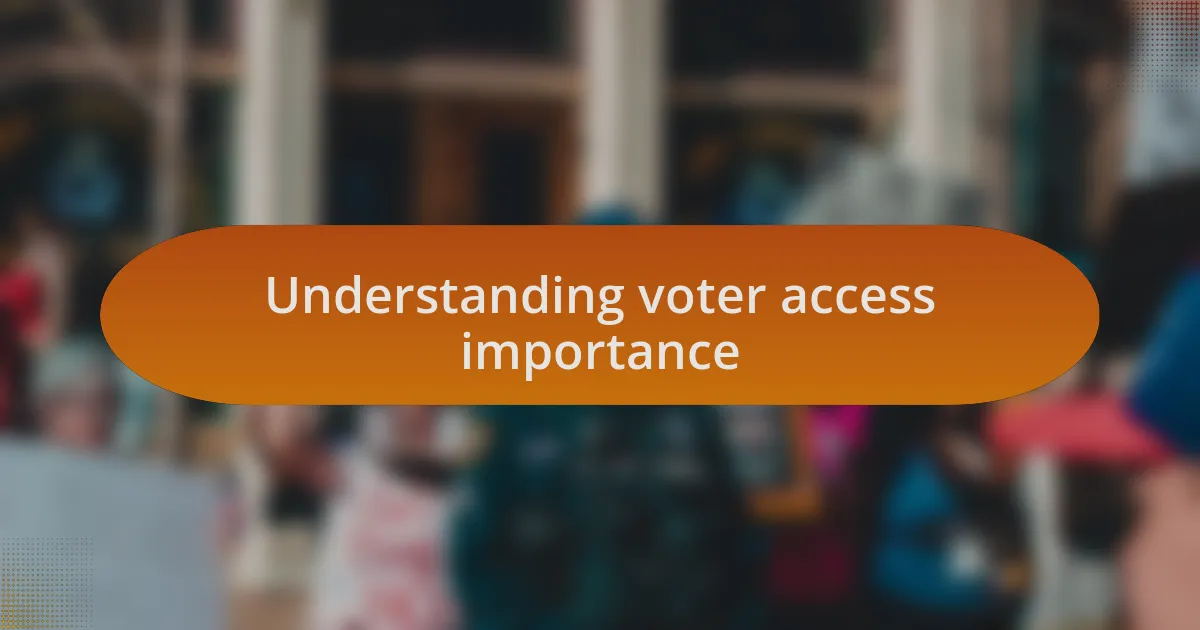
Understanding voter access importance
Voter access is vital for a healthy democracy. When citizens are denied or face barriers to casting their votes, it diminishes the public’s trust in the electoral process. I remember a time when I encountered long lines at my local polling station, which made me reflect: how many people simply gave up and went home?
Ensuring that everyone can vote means representing diverse perspectives and experiences. One election, I volunteered to help individuals navigate the voting process, and I was struck by the different challenges each person faced. It made me realize that for some, accessing a polling location is not just about distance but about having the right resources and information.
We often take for granted our ability to vote. But I’ve seen firsthand how disenfranchisement can affect communities. It leaves people feeling powerless and unheard, which raises the question: what can we do to foster an environment where everyone feels empowered to participate? I believe when we advocate for voter access, we’re not only protecting rights but also uplifting voices that deserve to be heard.
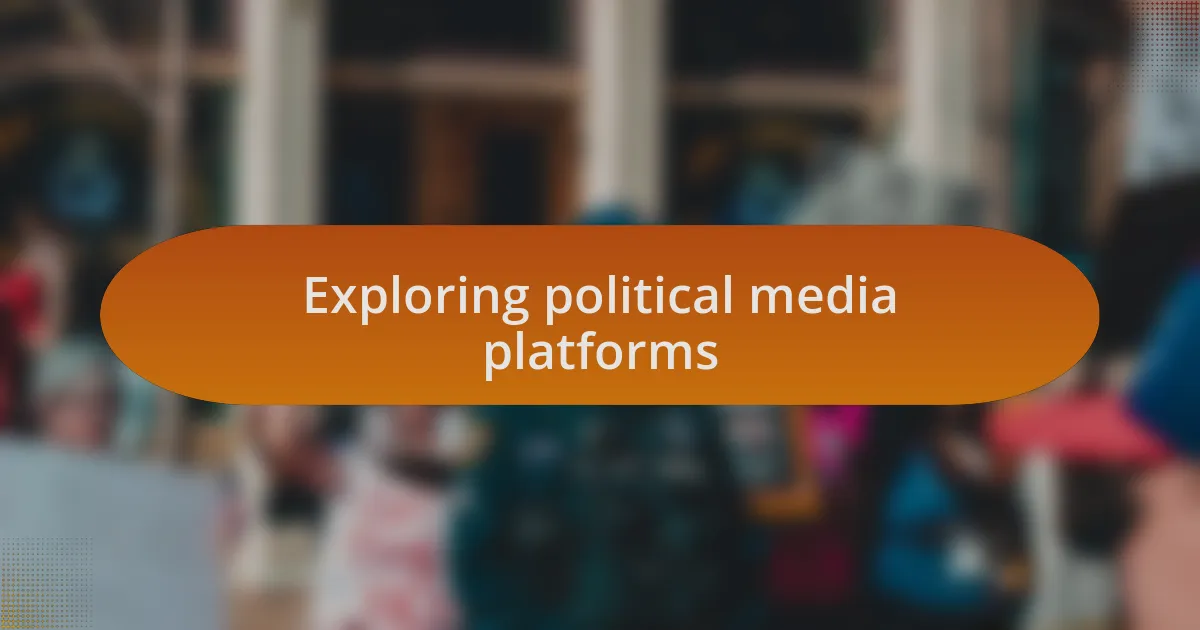
Exploring political media platforms
When I think about political media platforms, I can’t help but recognize their pivotal role in shaping public perception and access to information. I remember scrolling through various news sites during an election cycle, and noticing how different platforms presented the same issues in contrasting ways. This made me wonder: how does the framing of a story influence voter engagement and understanding?
The range of political media platforms today offers a double-edged sword. On one hand, they provide a marketplace of ideas that can enlighten voters about their rights and options. Yet, I’ve also observed how misinformation can spread like wildfire, especially on social media, leaving many confused or misled. Has anyone else felt overwhelmed trying to sift through the noise to find credible sources? I certainly have, and it underscores the need for stronger measures to highlight accurate information.
Engaging with political media also means recognizing the lived experiences of those who consume it. I recall a conversation with a friend who felt disillusioned after encountering biased reporting that misrepresented her views. It hit me then that for many, these platforms aren’t just tools for information—they’re gateways to feeling heard and validated in the political space. How can we, as consumers and advocates, push for more inclusive narratives that truly reflect the diversity of our society?
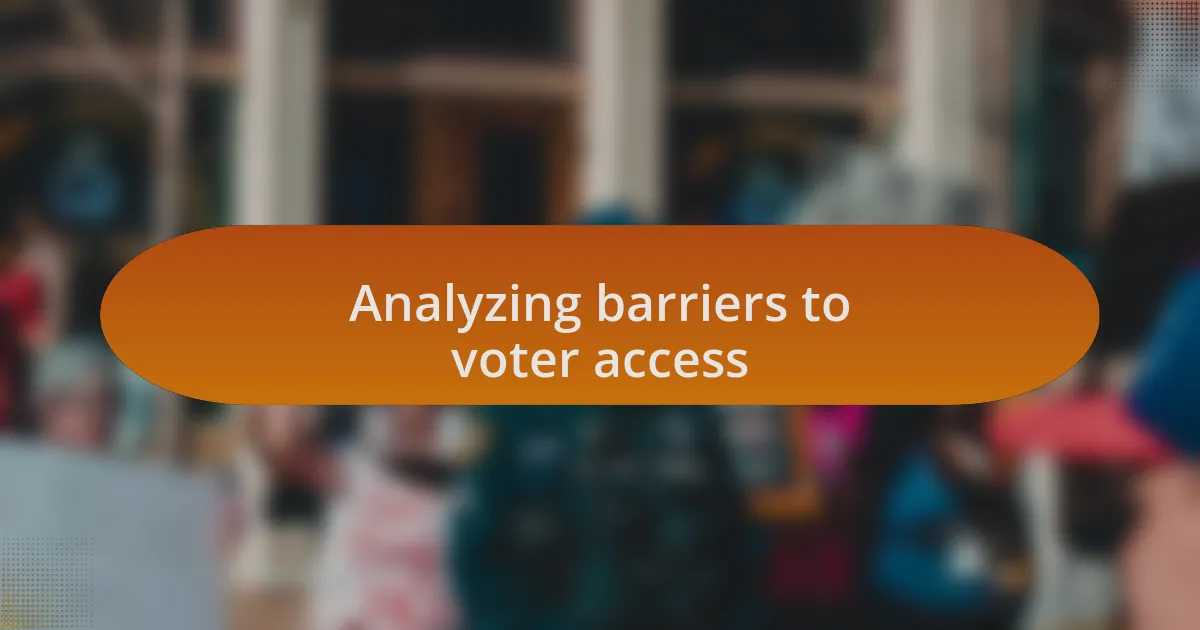
Analyzing barriers to voter access
Barriers to voter access can be significant, often appearing in various forms that might not be immediately obvious. Take, for instance, the bureaucratic hurdles I faced while helping a family member register to vote. It was eye-opening to see how the complex registration process, packed with legal jargon and varying state requirements, could discourage even the most motivated individuals. Has anyone else had a similar experience navigating the red tape?
One of the most insidious barriers is the lack of information about voting rights and the electoral process. I remember attending a community meeting where residents voiced their confusion over ID requirements, leading to a palpable sense of frustration. This made me realize that if people don’t understand what they need to participate, they might simply give up, feeling that their voices don’t matter.
Language accessibility is another pressing issue. During my volunteer work, I encountered numerous voters who struggled because they weren’t fluent in English. While providing materials in multiple languages is essential, I learned that having interpreters available at polling places could dramatically impact those voters’ experiences. How can we ensure that every individual feels confident and understood when exercising their right to vote?
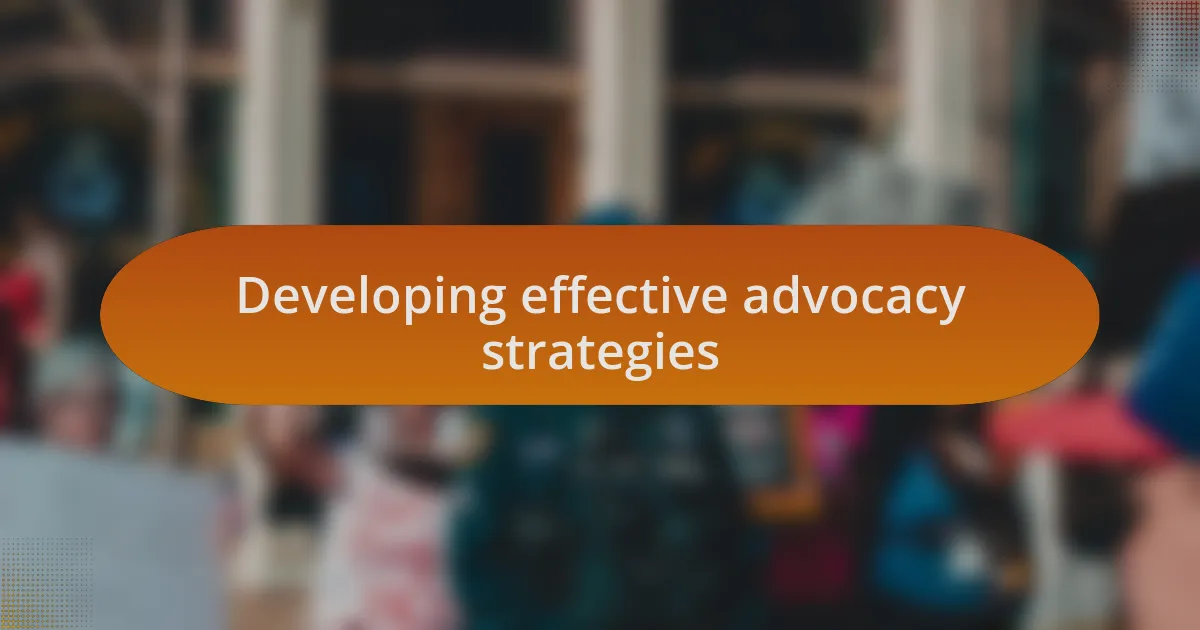
Developing effective advocacy strategies
Developing effective advocacy strategies starts with understanding your audience. I recall a community forum I organized where we gathered feedback directly from residents about their concerns. By actively listening, I was able to tailor our messaging to resonate with their unique experiences, making our advocacy efforts more impactful. How often do we forget that the voices we’re trying to amplify should shape our message?
Another vital element in advocacy is building coalitions. It’s not just about raising awareness but also about uniting various groups that share a common goal. By collaborating with local organizations focused on education and civil rights, I witnessed firsthand the strength that comes from diverse perspectives. When we pooled our resources, we multiplied our reach and created a wave of momentum that individuals could hardly achieve alone.
Finally, creating clear, actionable plans can steer advocacy efforts in the right direction. During our campaign to increase voter registration in underrepresented areas, we devised a step-by-step strategy that included community workshops and pop-up registration events. This not only empowered volunteers but also made participation feel accessible rather than overwhelming. Have you ever experienced the satisfaction of turning a daunting task into manageable steps?
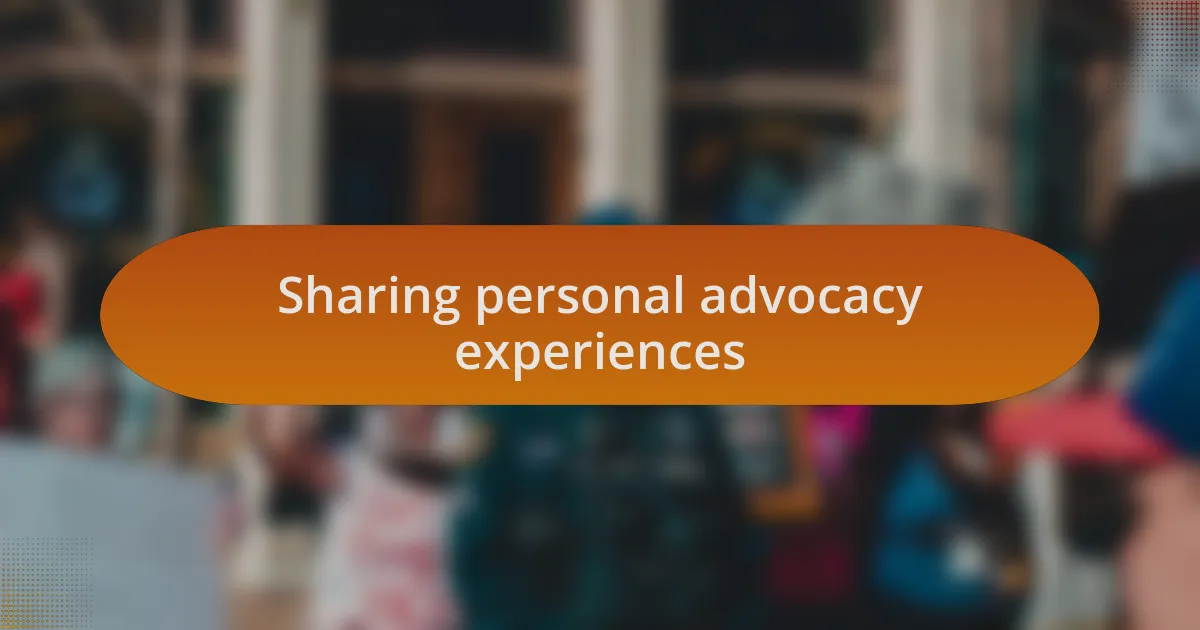
Sharing personal advocacy experiences
Advocacy is deeply personal, and sharing those experiences can create meaningful connections. I remember standing outside a local grocery store, collecting signatures for a petition aimed at improving ballot access. As I engaged with people in line, I was struck by how many had stories of frustration with the voting process. Their shared experiences fueled my passion, reminding me that advocacy isn’t just about policies—it’s about real lives affected by those policies.
One moment that stands out is when I helped organize an event for voters who spoke Spanish as a primary language. We invited community leaders to discuss the intricacies of the voting process and provided resources in Spanish. I could see the relief on their faces as they received the information they needed. This experience taught me the importance of language access in advocacy—how critical it is to ensure everyone can engage in democracy. Isn’t it empowering to help someone feel included in a process that should be universal?
Every story shared during these advocacy efforts deepens our understanding of the challenges people face. Once, a young woman approached me after a workshop, her eyes filled with determination mixed with fear. She had faced barriers to registration and felt invisible. Listening to her narrative reinforced my commitment to creating more inclusive platforms. How can we empower more individuals to share their stories? By cultivating environments where voices are valued and heard, we can inspire others to step into advocacy with courage.
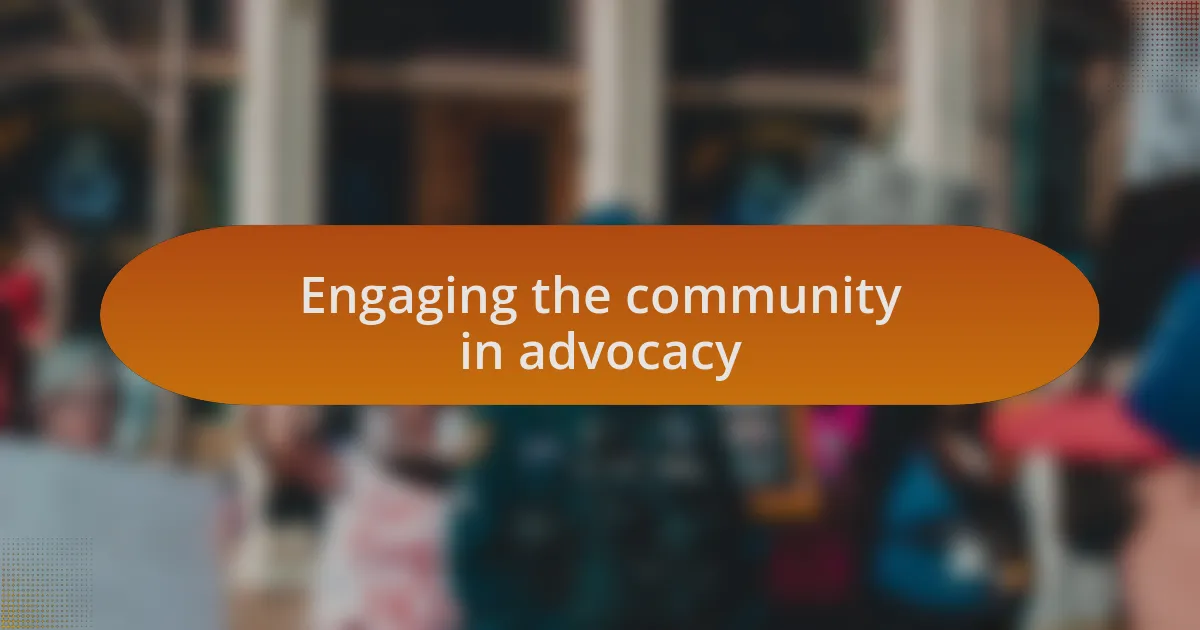
Engaging the community in advocacy
Engaging the community is all about creating spaces where voices can unite for change. I recall hosting a neighborhood discussion at a local library, where we chatted about voting obstacles. Watching community members connect over shared frustrations was eye-opening; it was as if their collective energy ignited a spark of empowerment. It made me realize how a simple gathering can cultivate a sense of belonging in advocacy efforts.
One memorable experience was partnering with a local youth organization to create voter education workshops. We tailored them to cater to high school students who were about to turn 18. The excitement in the room was palpable as they filled out their first voter registration forms. I couldn’t help but think, how often do we overlook the potential of young voices? Engaging students in advocacy not only informs them but also shapes the future voters we need in our democracy.
At times, I’ve been disheartened by the divide in our community regarding political discussions. However, during one event, I facilitated a dialogue between different demographic groups, allowing each person to share their perspectives. The compassion that emerged from these conversations was truly uplifting. Could it be that when we listen to each other, we pave the way for more inclusive advocacy? Building trust through open dialogue can transform skepticism into collaboration, strengthening our advocacy efforts in the long run.